An In-depth Exploration of Doves: Facts and Insights
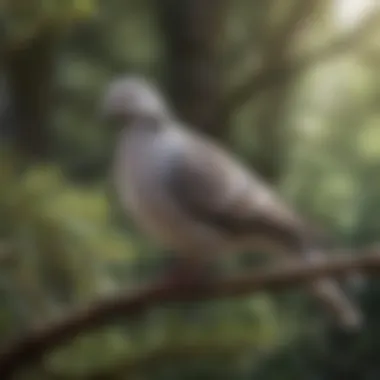
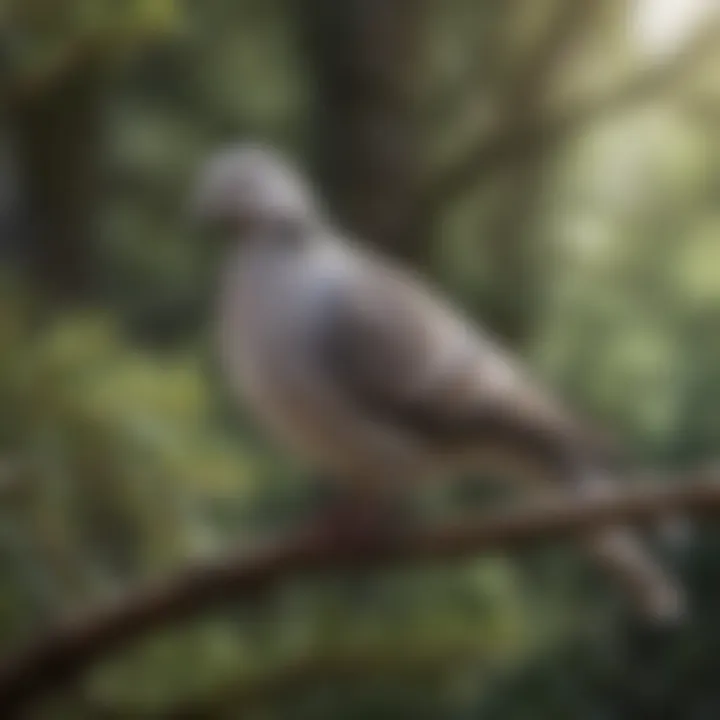
Intro
Throughout history, doves have held a special place in both nature and human culture. They symbolize peace, love, and harmony, capturing the imaginations of people worldwide. However, beyond their symbolic meanings, these birds have intriguing biological and behavioral traits that warrant a closer examination. This article aims to peel back the layers of the dove's existence, exploring their unique characteristics, their roles within ecosystems, and their connections to human society.
As we begin this journey, we will cover various subsections relating to doves, ranging from understanding them as pets to delving into their health and wellness needs. Whether you are an avid bird enthusiast, a pet owner hoping to glean insights about these charming creatures, or someone simply curious about doves, the information we present will be valuable and enlightening.
Understanding Your Pet
When bringing a dove into your home, the first step is understanding their unique traits and needs. Doves may seem low-maintenance, but they are not without specific care requirements that every owner should know.
Pet Behavior Basics
Doves are generally affectionate and social birds. They often form strong bonds with their owners, displaying behaviors such as cooing and preening when they feel secure and loved. Unlike some pets that may thrive on independence, doves seek companionship—either from humans or fellow doves. This social nature can lead to their contentment, hence it's often recommended to keep them in pairs or small groups. Doves also communicate through a series of cooing sounds, expressing emotions ranging from happiness to distress.
Common Breed Characteristics
There are several species of doves commonly kept as pets. Among these, the Ring-necked Dove and the Mourning Dove are popular choices. Each breed has its own set of characteristics:
- Ring-necked Dove: Medium-sized, known for its gentle temperament and a distinctive ring of feathers around its neck.
- Mourning Dove: Leaner body with a long tail and soft, grayish-brown feathers, famed for its mournful call.
Understanding these traits helps potential owners select a dove that aligns with their lifestyle and environment.
Species-Specific Needs
Every dove species has its preferences when it comes to habitat, diet, and socializing. While providing a spacious cage is a must, the internal environment should be enriched with safe branches, toys, and hiding places. A diet rich in seeds, fresh fruits, and greens keeps them healthy, aligned with their natural foraging insticts. Each species may vary slightly in their needs, so it's crucial to research prior to bringing one home.
Pet Care and Maintenance
Caring for doves involves understanding their nuanced needs and habits. A balanced approach to care ensures longevity and happiness.
Feeding Guidelines
Offering a proper diet is paramount. Doves thrive on seeds and grains but can also benefit from fresh fruits and cooked vegetables. Remember, variety is essential to maintain their health. Avoid feeding them avocado or chocolate as these can be harmful.
Grooming Essentials
While doves generally keep themselves clean, they may appreciate the occasional bath. Ensure there's a shallow dish of fresh water available for them to splash around. Regular handling will also help them get comfortable with you and support their social behavior.
Hygiene Practices
Maintaining cleanliness in their habitat contributes greatly to their well-being. Regularly clean the cage, replace food and water, and monitor for any signs of illness. Providing a clean environment can prevent infections and support their overall health.
Training and Development
Training doves may initially seem daunting, yet with patience and consistency, it's achievable.
Basic Commands and Skills
Teaching doves simple commands can be rewarding. Start with basic ideas like "come" or "stay" using treats as motivation. Repetition and positive reinforcement are key components here.
Behavioral Training Techniques
Using techniques such as clicker training can enhance their learning. This method pairs a distinct sound with positive outcomes, encouraging the dove to associate that sound with reward.
Addressing Common Behavior Issues
Sometimes, doves may develop habits like excessive cooing or feather plucking. Understanding the cause—be it boredom or stress—is vital. Ensuring they have enough stimulation can mitigate these issues effectively.
Health and Wellness
Prioritizing doves' health is fundamental to their care.
Routine Vet Check-ups
It’s advisable to schedule routine vet visits to keep track of your dove’s health status. Regular check-ups can catch potential problems before they escalate.
Vaccination Needs
Consult your veterinarian about necessary vaccinations to protect your dove from disease. Proper vaccination is as critical for birds as it is for other pets.
Recognizing Signs of Illness
Understanding your dove's normal behavior will help you detect early signs of illness. Watch for changes in appetite, droppings, or activity levels—these could indicate health issues that require attention.
Enrichment and Activities
Engaging your dove through various activities is essential for their mental and physical health.
Indoor vs. Outdoor Activities
Doves enjoy flying and stretching their wings. If the environment allows for safe outdoor time, consider allowing your dove supervised exploration. Indoor activities can include navigating obstacle courses made from toys and other materials.
Interactive Toys and Games
Incorporating interactive toys can keep them engaged. Consider small swings, perches, or even puzzles designed for birds that challenge their intellect while providing fun.
Socialization Opportunities
Encourage social interactions, either with humans or other doves. This socialization not only enhances their bonding but also contributes to their emotional health.
"Caring for a dove isn't just about meeting its needs; it's about understanding and connecting with a being that thrives on companionship and love."
In understanding these various facets of dove care, owners can foster a fulfilling relationship with their feathered friends, ensuring that they lead vibrant and healthy lives.
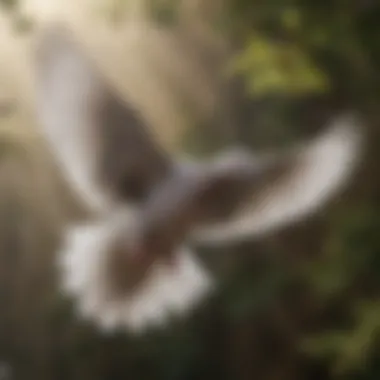
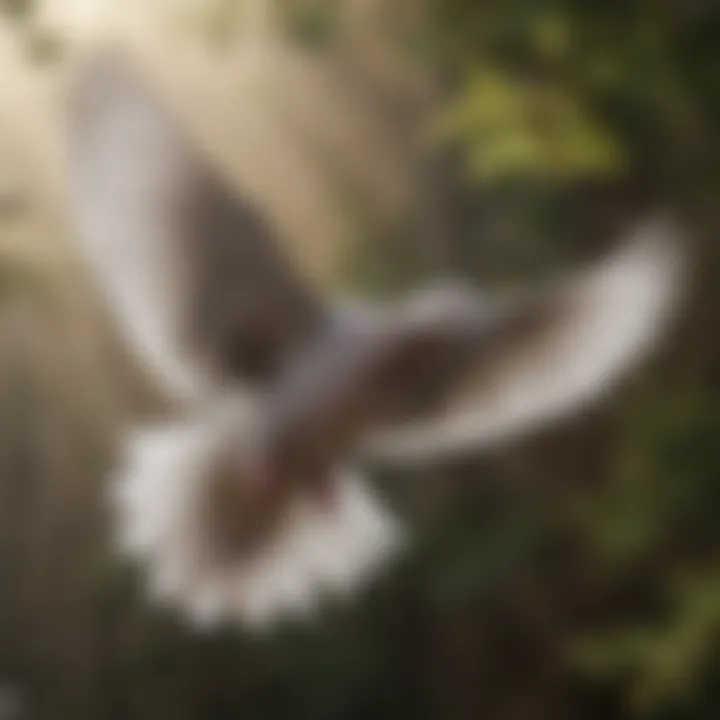
Prelude to Doves
Doves have long captured the fascination of humans, embodying the essence of peace and fidelity. Their gentle cooing and serene presence often evoke a sense of tranquility. This section serves as an essential introductory framework, not just to the nature of doves, but also to their intertwined roles within ecosystems and human culture.
Defining Doves
Doves, scientifically classified under the family Columbidae, are generally characterized by their stout bodies, short necks, and small heads. While they come in diverse shapes and sizes, they typically range from 8 to 16 inches in length. These birds are often identified by their soft voices, which are distinctively soothing. A defining characteristic is their unique feather coloration that can range widely—some doves flaunt shades of iridescent greys and whites, while others present a more vibrant palette.
Interestingly, the term "dove" doesn't only refer to one specific species; rather, it encompasses a variety of species across the globe. Common examples include the mourning dove and the rock dove, both of which can frequently be seen in urban and rural environments. Understanding the diversity within the family Columbidae lays the groundwork for appreciating their behaviors and characteristics.
The Relationship of Doves to Pigeons
Doves and pigeons are often discussed interchangeably, leading to some confusion. However, there are nuanced differences worth noting. In a broad sense, all doves can be considered pigeons, but not all pigeons are doves. Pigeons generally refer to larger species within the same family.
For instance, the rock dove, commonly known as the feral pigeon, is often found in cityscapes, while the smaller mourning dove typically roams open fields and gardens. Furthermore, the variations in their size affects sociability and behavior. Doves tend to be more solitary creatures compared to pigeons, which often flock together in substantial numbers.
In essence, recognizing the intertwined heritage of doves and pigeons not only enriches our understanding of these birds but also broadens the perspective on their roles in various ecosystems. Their unique adaptations and social behaviors stand testament to their survival and significance in the natural world.
Biological Characteristics
When investigating doves, the focus on biological characteristics offers a window into their adaptability and survival strategies. Understanding their physical traits provides important insights into how these creatures thrive in varied environments and maintain their populations. Key elements like size, coloration, reproductive behavior, and care arrangements contribute not just to the species' ecology, but also to their commingling with humans as pets.
Physical Features
Size and Weight
The size and weight of doves can vary significantly depending on the species, but most fall within a range that makes them relatively lightweight and easy to manage. Typically, doves can weigh anywhere from about 4 to 14 ounces and measure around 8 to 12 inches in length. This compactness plays a pivotal role in their flight ability. Being lighter allows them to escape predators efficiently, giving them a tactical edge. In addition, their body size affects their habitat choices, as smaller species tend to inhabit dense vegetation that offers numerous escape routes.
The unique aspect to consider is how size influences the care these birds often require in a domestic setting. For instance, smaller doves like the diamond dove are favored among pet enthusiasts due to their gentle nature and adaptability to smaller living spaces. However, being smaller also means they have different space and social needs compared to larger populations.
Color Variations
In the dove world, color can also be quite the showstopper. Doves exhibit an array of hues, from the common grey and white plumage to rare color morphs like pied and pastel. This diversity in color is not only visually appealing but also serves vital roles in camouflage and mate selection. Certain species, like the ringneck dove, flaunt intricate patterns that aid in attracting partners during the breeding season.
One notable feature is how color affects their interaction within the wild community. In regions with varying backgrounds, bright or patterned feathers can serve as either a benefit or a disadvantage. Bright plumage helps in courtship but may also attract unwanted attention from predators. The interplay between beauty and survival remains a captivating aspect of dove biology, adding depth to their overall profile.
Beak Structure
Doves possess a conical beak structure that is perfectly designed for their diet, which primarily consists of seeds and soft fruits. This beak shape allows them to crack seeds open efficiently, illustrating the relationship between their anatomical features and feeding habits. Simple yet effective, the design showcases their adaptability to varied food sources.
Another interesting point is how the beak is a determining factor in their social interactions. For example, doves with slightly larger beaks may dominate feeding spots, leading to the natural establishment of a hierarchy amongst birds. Though small, the beak is instrumental in shaping social dynamics, feeding behaviors, and even their interactions with humans in a domestic context.
Reproductive Behavior
Nesting Patterns
Understanding how doves build their nests reveals a lot about their parenting styles and environmental adaptability. Generally, doves prefer to construct their nests in sheltered spots, utilizing twigs, grass, and other natural material they can easily gather. This scrappy approach ensures their eggs are camouflaged from potential predators. One prominent characteristic of dove nesting is a lack of intricate design; their nests are often seen as unrefined but demonstrate functionality over decoration.
Moreover, nesting habits vary across regions and species. Urban doves might opt for more unconventional nesting locations, such as rooftops, where safety often trumps the need for camouflage. As a result, this adaptability allows them to flourish in human-dominated spaces without skipping a beat.
Egg Incubation
Egg incubation in doves is a fascinating phenomenon. Generally, females lay one to two eggs, which are then incubated jointly by both parents for about 14 to 19 days. This cooperative breeding is essential for the survival of the chicks, as both parents engage actively in keeping the eggs warm and free from potential dangers.
The key characteristic here is the division of labor between the adults, which reinforces the familial bond. This nurturing behavior can foster stronger social ties among pairs, increasing the likelihood of future breeding success. However, if done in an environment with high disturbance, this method can sometimes pose a risk, leading to increased stress on the parents and potentially affecting the hatchlings.
Parental Care
Dove parenting is remarkably attentive, with both male and female doves participating in caring for their fledglings. Although each species shows slightly different behaviors, general patterns show a strong emphasis on nurturing post-hatching, where parents feed their young a substance known as pigeon milk. This substance is produced in the digestive systems of the adults and serves as nutritional nectar for the chicks.
The unique aspect of this parental care is its efficiency. With a relatively quick nestling period of around two to three weeks, doves can produce multiple broods in a breeding season, allowing their populations to stabilize rapidly. However, this rapid breeding can pose challenges if resources are scarce or predators are prevalent, which often leads to a discussion regarding conservation efforts in various environments.
"Understanding the intricacies of dove biology not only enriches our perspective on these beautiful creatures but strengthens the bond we form with them as companions and symbols of peace."
Through delving into these biological characteristics, we see how doves effectively navigate their lives, and the ways in which their features and behaviors impact their survival and relationship with humans. Recognizing these facets helps create a broader understanding of why they hold significance—not just as wildlife, but as cherished pets, symbols in culture, and participants in healthy ecosystems.
Dove Habitat and Distribution
Understanding the habitat and distribution of doves is key to comprehending their lifestyle and behaviors. Doves thrive in various environments, adapting to both natural and man-made spaces. This section will outline how their habitats influence their feeding, breeding, and social behaviors.
Natural Habitats
Woodlands
Woodlands are crucial environments for many dove species. They provide essential cover and access to natural food sources such as seeds, fruits, and berries. The trees and shrubs create a sanctuary where doves can build nests and rear their young in relative safety. One of the most appealing aspects of woodlands is the rich biodiversity they support, which also benefits doves. These areas tend to have a variety of insects and plants that enhance the foraging opportunities for these birds.
However, there's a downside. Woodlands can be fragmented by urban development, reducing the available space for doves to thrive. This natural habitat requires careful management to balance ecological needs.
Urban Areas
Doves have shown an impressive ability to adapt to urban areas. Cities provide abundant food sources, often taking advantage of discarded food items and ornamental plants. Urban areas also present unique nesting locations, such as buildings and parks, providing adaptable options for these birds. The key feature of urban settings is their accessibility; doves can easily find places to perch and forage.
Yet, urban life brings its challenges. Increased human activity can lead to disturbances, and vehicle traffic poses a constant threat. Still, many species, like the rock dove, have thrived in cities, highlighting the resilience of these remarkable birds.
Farmland
Farmland might not be the first environment that comes to mind for doves, but it plays a significant role in their distribution. Agricultural landscapes often consist of open fields that are rich in seeds, making it a prime feeding ground for doves. Crops like wheat and corn attract doves and offer predictable foraging patterns, increasing their chances of survival and reproduction.
Nevertheless, the cultivation practices can also be a double-edged sword. Pesticides and habitat alteration can harm dove populations. Additionally, the seasonal nature of farms means that the availability of food can fluctuate greatly. Farmers and conservationists alike must find a delicate balance between production and preservation to ensure doves can continue to thrive.
Global Distribution
Common Species by Region
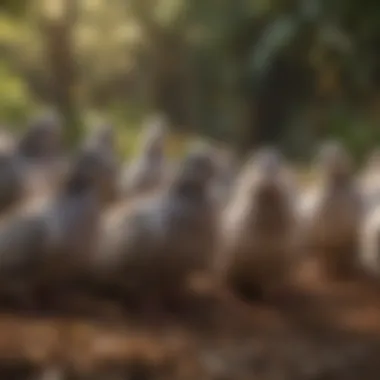
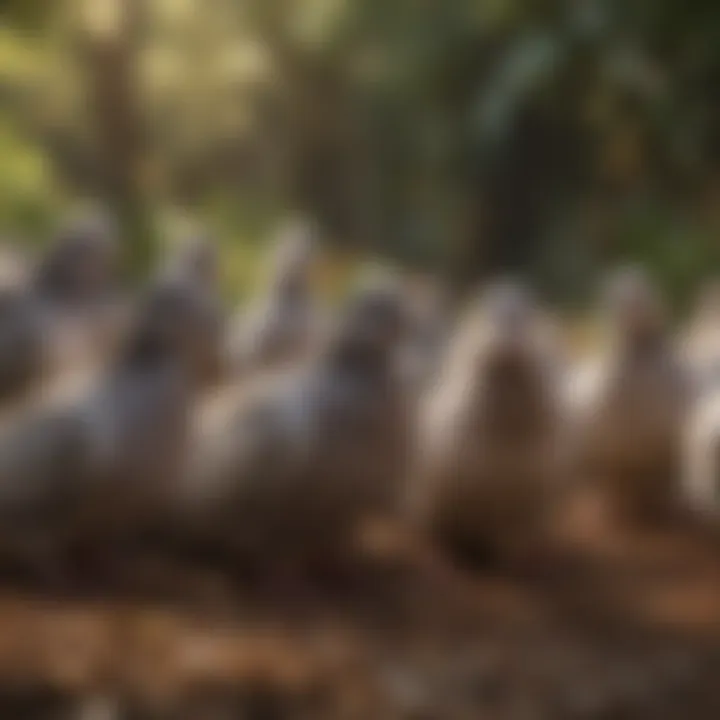
Doves are found across the globe, with specific species adapted to various regions. For instance, the mourning dove is widespread in North America, often spotted in backyards and parks. In contrast, the collared dove is prevalent across Europe and parts of Asia. The adaptability of these species showcases how doves fit into diverse ecosystems and human environments. Understanding their distribution helps pinpoint conservation efforts.
The unique feature here is their ability to occupy multiple niches, depending on the species and region. As pet owners or bird enthusiasts, knowing where to find these species allows us to appreciate their presence and support their habitats.
Habitats Shifts with Climate Change
Climate change is posing significant challenges to dove populations. As habitats shift due to changing climate, some species may find their food sources and nesting grounds compromised. For example, warmer temperatures can alter migration patterns and timing of breeding, which can affect reproductive success. It's crucial to acknowledge that the unique ecological conditions that support dove populations are becoming increasingly vulnerable.
"Preservation of habitats is imperative for maintaining biodiversity, particularly as shifts in climate continue to affect species like doves."
Diet and Feeding Habits
Understanding the diet and feeding habits of doves is vital. It sheds light on their role in ecosystems and their adaptability to various environments. Doves primarily rely on seeds, grains, fruits, and berries, which provide them with essential nutrients. A proper understanding of these dietary needs can enhance the experience of keeping doves as pets and also inform conservation strategies in wild populations. Thus, knowing what fuels these birds can inform us about their health, breeding success, and their overall well-being.
Typical Diet
Doves have a varied diet rooted in their natural behaviors. Their primary food sources include:
Seeds and Grains
Seeds and grains are fundamental to a dove's diet. Doves typically consume a wide range of seeds such as millet, sunflower seeds, and corn. This variety of seeds offers doves the necessary proteins, fats, and carbohydrates which are critical to their health. They have a unique adaptation in their digestive systems that allows them to extract maximum nutrients from these hard foods.
Feeding on seeds and grains not only provides essential energy but also aids in maintaining their feather quality and overall vitality. For pet owners, offering a balanced seed mix ensures that your dove remains happy and healthy. However, one must be cautious of overfeeding, as seeds high in fat can lead to obesity if not balanced with other foods.
Fruits and Berries
In addition to seeds and grains, fruits and berries play a significant role in a dove's diet. Items like apples, bananas, and berries add vital vitamins and hydration to their meals. These natural foods are well-loved by doves and can encourage natural foraging behavior, which keeps them mentally stimulated.
One appealing aspect of fruits and berries is their low-calorie nature, making them a great snack option. It's important to note, however, that some fruits should be offered in moderation. Fruits such as avocado can be toxic to doves, so it's imperative to research before introducing new items into their diet.
Feeding Strategies and Adaptation
Doves exhibit remarkable feeding strategies that show their adaptability. They often have a deliberate feeding style. When foraging, doves pick up small morsels and, using their powerful beaks, crack tough seeds open to reach the nutritious insides. They also engage in a behavior known as grit consumption, where they swallow small stones to aid digestion—much like many birds do.
In urban settings, doves have adapted to human presence and can often be seen scavenging for breadcrumbs and other food scraps. This adaptability highlights their resilience and ability to thrive in varied environments.
In sum, a dove's diet is a critical element of its health and well-being. By understanding their dietary needs—right from seeds to fruits—owners can ensure their pets enjoy a nutritious and diverse menu while wild doves continue playing their roles in the ecosystem.
Behavioral Patterns
Behavioral patterns in doves provide a fascinating insight into their social structures and survival strategies. Understanding these behaviors not only enhances our appreciation of these creatures but also informs how we may better care for them as pets. The dynamics of how doves interact with each other shed light on their adaptations and roles within both domestic and wild environments.
Social Behavior
Pair Bonding
Pair bonding in doves is a significant aspect that highlights their monogamous nature. These birds often form lifelong partnerships, which can lead to stability within their environment. The key characteristic of dove pair bonding is their commitment to one another, resulting in joint parenting and communal feeding during rearing periods. This bond not only fosters a secure environment for raising young but also promotes cooperation in nest building and defending their territory.
The unique feature of this bonding behavior is that it offers an emotional connection between mates, which some may argue resembles a friendship. For pet owners, understanding this can be advantageous as it informs how to house doves—for example, pairing them ensures they feel more at ease, reducing stress. However, should one dove in the pair become sick or pass, the surviving partner can exhibit signs of distress, indicating a downside to such deep connections.
Flocking Dynamics
Flocking dynamics significantly contribute to how doves navigate their environments and safeguard themselves against potential threats. Doves often establish flocks, which can vary in size and composition depending on the season and the availability of resources. The prominent characteristic of these dynamics is the concept of safety in numbers; by flocking together, they can better detect predators and have a higher chance of survival.
A unique aspect of their flocking behavior is that it allows for social interactions beyond mating. Doves socialize in flocks, engaging in grooming and play, which strengthens social bonds and individual well-being. However, one potential disadvantage in captivity is that overly large groups can lead to competition for resources, which may cause stress among the birds.
Communication Methods
Doves possess a rich array of communication tools, each serving a distinct purpose in interacting with their environment and each other. From vocalizations to body language, these methods are essential in expressing needs and emotions.
Vocalizations
Vocalizations in doves are a fundamental aspect of their social interaction. A key point regarding dove vocalizations is that they use varying sounds to communicate different messages. For instance, the soft cooing sound is often a sign of contentment and reassurance, while harsher calls can indicate distress or alertness to danger. This vocal repertoire not only enhances social bonds during pair bonding but is also a critical indicator of their emotional state.
The unique nature of their sounds, often melodic and soothing, makes them appealing pets. For owners, recognizing these sounds can aid in addressing their needs—be it hunger, anxiety, or contentment, though it can be challenging to differentiate between subtle variations of vocalizations without experience.
Body Language
Body language in doves is another crucial communication method that adds depth to their interactions. The way doves position themselves, preen, and share space says a lot about their feelings and intentions. A relaxed stance with feathers slightly puffed indicates comfort, while raised feathers or a puffed-up appearance can signal aggression or fear.
A significant feature of dove body language is its context-dependence; subtle shifts in posture can indicate shifts in mood. Understanding these signs is beneficial, especially for pet owners, as it enhances their relationship with these birds. Yet, misinterpretation of these signals can lead to stress in doves if, for example, they feel threatened due to an improper approach or environment.
Key Takeaway: Understanding the behavioral patterns of doves, including their social interactions and communication methods, plays a crucial role in fostering a nurturing environment for dove pets and enhancing appreciation for their existence in the wild.
Cultural Significance of Doves
Doves have long held a special place in human cultures around the world. Their presence in various artistic expressions and traditions reveals their importance beyond mere biological aspects. Doves symbolize peace, love, and even sacrifice in different contexts, embodying values that resonate deeply with many societies. From literature to religious texts, doves serve as powerful icons that evoke emotions and convey messages.
Symbolism Across Cultures
Peace and Love
One of the most prominent aspects of doves lies in their association with peace and love. Throughout history, they have been seen as symbols that bridge gaps between communities and promote harmony. Doves have graced the imagery of peace treaties, cultural celebrations, and even in everyday sayings. The image of a dove carrying an olive branch is instantly recognizable as a message advocating for tranquility.
This representation of peace and love is compellingly attractive because it transcends geographical and cultural boundaries. It pulls at the heartstrings of many, reminding us of our common desire for unity and goodwill. Celebrations of love, such as weddings, often feature doves as a central motif, emphasizing commitment and fidelity.
A notable aspect of this symbolism is its emotional weight. People often release doves during special ceremonies to signify new beginnings, evoking a sense of hope and renewal. This practice highlights the unique ability of doves to encapsulate sentiments that are beautifully human while also allowing individuals to reflect on their aspirations for harmony.
Religious Symbolism
In the realm of spirituality, doves carry profound connotations. Various religions feature doves prominently, serving as symbols of divine messages and guidance. In Christianity, for instance, doves are typically associated with the Holy Spirit, as depicted in the Bible. The story of Jesus’ baptism features a dove descending from the heavens, representing purity and divine approval.
This religious symbolism connects believers to a broader narrative, reinforcing feelings of faith and trust. Much like the representation of peace, the dove’s role in religious contexts causes it to be a popular choice for various ceremonial practices, blessings, and rites of passage.
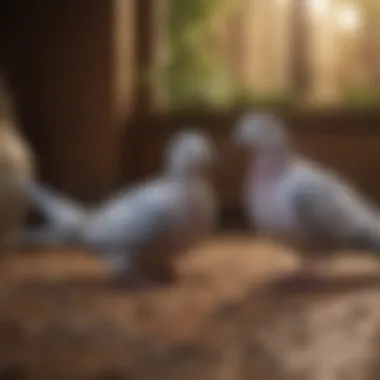
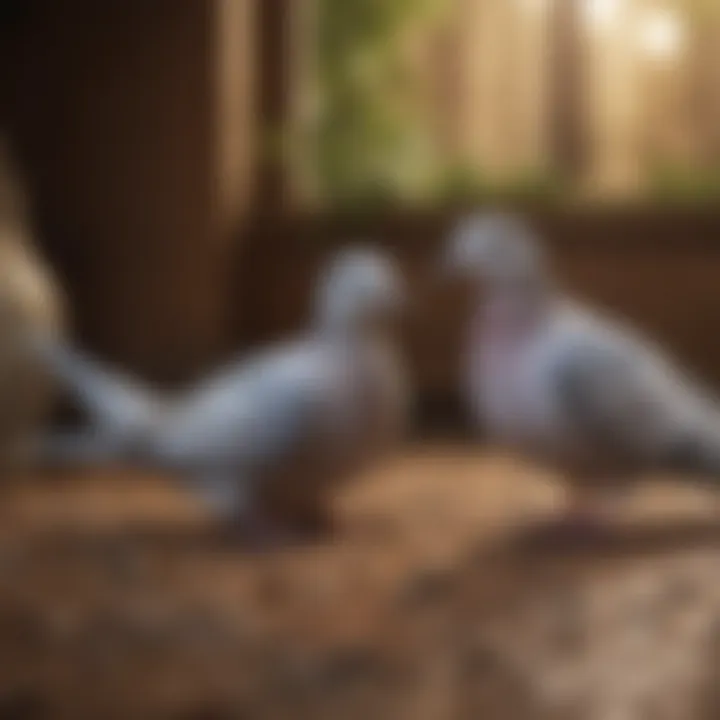
The unique feature of religious symbolism is its ability to bring diverse communities together under shared beliefs. While doves may have different meanings across faiths, their fundamental essence as symbols of hope and renewal remains consistent. This adaptability makes them valuable icons in fostering understanding among different cultures and faith traditions.
Doves in Literature and Art
Doves' presence in literature and art provides a rich tapestry of interpretations, capturing their multifaceted roles in human life. Authors and artists have often employed the imagery of doves to convey themes of love, freedom, and transcendence. In poetry, doves can symbolize longing or tenderness, while in visual arts, they often appear as serene elements in landscapes or poignant scenes.
The recurrent use of doves in creative expressions further amplifies their significance to society. Artists and poets can write about the fragility of love and peace, inspiring audiences to consider their roles in promoting these ideals. This impact shows that doves are more than just birds; they are vital representations of human emotion and aspiration.
"Doves are not just creatures of nature; they carry our dreams and desires, becoming mirrors to our collective spirit."
As a result, the cultural essence of doves transcends their biological existence, merging into our societal narratives and encouraging deeper reflection on peace, love, and spirituality.
Doves as Pets
When it comes to choosing a pet, doves hold a unique spot on many people's lists. They are gentle, low-maintenance companions that fit well into a variety of living environments. Knowing about doves as pets can transform how one relates to them and influence decisions on care and companionship. The quiet nature of these birds often pairs well with home life, making them suitable for families, especially those with children. They can serve as a great introduction to pet care for young ones, teaching responsibility without being overwhelming.
Common Pet Dove Breeds
Netherland Doves
Netherland Doves, also known as the Dutch Tumbler, stand out due to their compact size and elegant appearance. Their fluffy feathers and small stature make them a favorite among pet owners. They are relatively easy to care for, requiring only a spacious cage, fresh water, and a proper diet. What sets Netherland Doves apart is their endearing personality; they tend to interact well with humans, often being friendly and curious. This breed is particularly beneficial for those looking for a pet that provides companionship without the loud coos associated with larger dove species. However, they may need a bit of time to adjust to new environments, so patience is key when bringing them home.
Ringneck Doves
On the other hand, Ringneck Doves are commonly recognized due to the distinctive ring of color around their necks. They are larger than Netherland Doves and have a more robust build. This breed is also incredibly social and can even learn to mimic sounds, which is a fun feature for households looking for interactive pets. Ringneck Doves stand out for their adaptability; they can flourish in varied living conditions, from urban apartments to large houses. Nonetheless, environmental noise can sometimes be challenging for them, and they prefer a calmer atmosphere. Their sociable nature makes them excellent for families, but potential owners should be prepared to provide companionship or keep more than one dove to prevent loneliness.
Care Requirements
Housing Needs
Proper housing is the backbone of dove care. Doves require a spacious cage that allows them room to stretch their wings. A well-constructed cage with horizontal bars is ideal because it enables them to climb—an important aspect of their wellbeing. It's advisable to choose a cage at least 24 inches long, 18 inches wide, and 18 inches high for a couple of small doves. Adding natural perches, toys, and nesting materials can also enhance their living space. Regular cleaning is important to keep their environment healthy and to prevent any buildup of waste. Failure to provide a clean habitat can lead to health issues, so maintaining a routine can help keep your doves happy and healthy.
Nutrition and Health
Doves thrive on a balanced diet rich in seeds and grains, but it's crucial to supplement their diet with fresh fruits and vegetables. Foods like leafy greens, carrots, and oats should be included to ensure they receive essential nutrients for their health. Another vital aspect of dove nutrition is offering grit, which aids in digestion.
Healthwise, doves generally need regular check-ups to keep potential diseases at bay, especially if they show changes in behavior or appetite. These birds can suffer from a range of health issues, so awareness of symptoms like lethargy or unusual droppings is beneficial. Adequate hydration is also fundamental—doves should have access to fresh, clean water at all times. Understanding the nutritional and health needs of doves ensures a long and fulfilling companionship.
"Doves bring joy and companionship, but understanding their needs is key to a healthy relationship."
In summary, doves make wonderful pets with their gentle natures and aesthetic appeal. Knowing about their specific breeds and care requirements can turn the experience into something fulfilling. Choosing the right breed like Netherland or Ringneck Doves and providing adequate housing and nutrition can help create a lasting bond with these remarkable creatures.
Conservation Status and Efforts
Doves hold a special place in both nature and human culture, but their populations are under significant threat. Understanding the conservation status of these birds is crucial not only for their survival as a species but also for maintaining the balance of ecosystems they inhabit. In today’s world, many dove species are facing challenges that could impact their long-term viability. This section dives into the specific threats doves face, as well as the initiatives designed to protect them. The significance of these efforts can't be overstated, as they contribute to biodiversity and enrich our shared environment.
Threats to Dove Populations
Dove populations are declining due to a variety of factors, many of which stem from human activity. Key threats include:
- Habitat Loss: Urban expansion and agricultural practices often encroach upon natural habitats, leaving doves with limited space to thrive.
- Hunting and Trapping: In some regions, doves are hunted for sport or captured for trade, which can severely impact local populations.
- Climate Change: Shifts in weather patterns can alter food availability and nesting conditions, making survival more challenging.
- Predation: As their habitats shrink, doves become more vulnerable to predators, which can lead to decreased numbers.
These pressures not only threaten individual species but also disrupt entire ecosystems, underscoring the need for immediate conservation action.
Conservation Initiatives
Efforts to conserve dove populations involve a combination of habitat restoration and breeding programs. These initiatives aim to address the threats mentioned above and play a vital role in ensuring doves endure for future generations.
Habitat Restoration
Habitat restoration focuses on revitalizing areas where doves and other wildlife have suffered from degradation. This approach is integral for several reasons:
- Ecological Balance: Restoring habitats helps maintain the natural order, allowing numerous species to flourish together. Doves rely on specific environments for foraging and nesting.
- Biodiversity: Healthy ecosystems support varied life forms, providing doves with essential food sources and safety from dangers.
Unique features of habitat restoration include:
- Native Plant Reintroduction: Using local flora that supports the indigenous wildlife, including doves, can create more suitable environments for them.
- Community Engagement: Involving local stakeholders in restoration efforts fosters a sense of ownership and commitment to conservation.
However, challenges exist. Restoration projects can be costly, and results may take years to become evident, which sometimes leads to diminishing immediate support.
Breeding Programs
Breeding programs target specific dove species that are at risk of extinction. They focus on cultivating viable populations in captivity to bolster numbers in the wild. The key characteristics of these programs include:
- Genetic Diversity: Breeding efforts aim to ensure a genetic mix that promotes healthy, resilient populations.
- Public Education: These initiatives often involve educational components to raise awareness about the plight of doves and how communities can help.
A unique aspect of breeding programs is their potential to reintroduce cultivated doves back to their natural habitats. This provides a pathway for recovering populations, but the programs can face criticism. Some argue they can only serve as a band-aid solution without addressing the root causes.
"Protecting doves is not just about saving a species; it reflects a commitment to ecological harmony that benefits all forms of life."
Engaging in conservation work is crucial for the survival of doves and emphasizes our shared responsibility to protect the world we inhabit. As we explore more about our avian companions, it becomes clear that their fate is intertwined with ours.
Epilogue
The conclusion of this article plays a pivotal role in weaving together the expansive knowledge shared about doves throughout the different sections. This final segment strives to not only summarize essential insights but also reflect on the broader implications of doves in our lives and ecosystems. Understanding doves is crucial, reinforcing the interconnection between humans, nature, and animals. It prompts readers to delve deeper into the behavior and significance of these creatures, both in the wild and as pets.
Recap of Key Insights
To recap, doves are not just simple birds; they possess intricate biological traits, fascinating behaviors, and rich cultural significance. Some pivotal insights that have emerged from this exploration include:
- Biological Characteristics: Doves showcase remarkable physical features, from their size variations to colorful plumage that can be quite striking.
- Habitats and Distribution: Their adaptability to diverse environments—from lush woodlands to bustling urban centers—highlights their resilience.
- Diet and Feeding Habits: A diet focused on seeds and fruits provides insight into their role in the ecosystem as vital seed dispersers.
- Cultural Significance: Across multiple cultures, doves symbolize peace and love, establishing a profound connection with human stories and traditions.
- Conservation Efforts: Recognizing the threats faced by doves emphasizes the importance of community-driven conservation initiatives.
This knowledge not only enriches our understanding but highlights the need for a continual commitment towards environmental stewardship.
Reflecting on Human-Dove Relationships
The relationship between humans and doves is layered and compelling. Doves often find themselves at the heart of human traditions—whether in wedding ceremonies symbolizing love or art that evokes a sense of serenity. As companions, doves can offer warmth and affection to pet owners, often forming unique bonds similar to those seen with more traditional pets.
Engaging with doves requires a blend of empathy and responsibility. Understanding their needs can lead to a rewarding experience for families introducing these animals to their homes. Simple things like observing their social behaviors or learning their dietary preferences can foster respect and admiration.
In a world that often feels detached from nature, doves serve as gentle reminders of life's delicate balance. For those who take the time to explore their behaviors and engage with their presence, the rewards are substantial. Whether as pets or merely as subjects of admiration in the wild, doves enrich our lives in ways that are profound and lasting.







